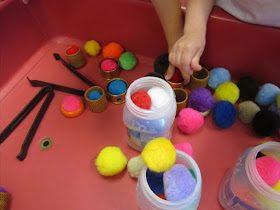For the past few weeks, I’ve been writing about ways to introduce loose parts in the classroom
with the idea that intentional planning of the environment can help the children structure their play in a way that is
both open ended for children and manageable for adults.
One area of the classroom that lends itself to loose
parts play is the sensory table. Very often, sand and water play focus on the
simple tasks of filling and dumping. These skills are developmentally
appropriate, especially for younger children, but are also self-limiting,
because once the skills of filling and dumping are achieved, what’s next? The
tools that children are given to fill and dump water and sand also sometimes
interfere with their play. Buckets and shovels that are suitable for a sandbox
take up too much space in the table, and children’s broad motions of scooping
often fling sand and water onto other children and the floor, frustrating
teachers and leading them to limit this play, or to wonder whether sensory table play is really worth it.
Adding loose parts (beads, shells, buttons, rocks, animals, etc.) to the material in the sensory table can open a whole new dimension of sensory play as children hunt for hidden objects, sort and classify, and pretend. Adding containers and scoops that are small enough to handle easily without taking up too much room or spilling on the floor can help make this area more manageable for adults.
Adding loose parts (beads, shells, buttons, rocks, animals, etc.) to the material in the sensory table can open a whole new dimension of sensory play as children hunt for hidden objects, sort and classify, and pretend. Adding containers and scoops that are small enough to handle easily without taking up too much room or spilling on the floor can help make this area more manageable for adults.
Loose parts in sand lead to digging, hiding and searching, sorting, classifying, counting, and patterning. Combining different loose parts with containers that are different sizes and shapes encourages mathematical thinking and experimentation.
Adding an additional surface inside the table (a small shelf, or a hollow block or plank) gives children the work space to
arrange objects and fully carry out their ideas.
Loose parts in water also lead to sorting, classifying, and counting, with the added opportunities to explore scientific properties like sinking and floating. Adding containers such as toy boats, cups, or plates give more objects to compare and experiment with.
Dark water (colored with black or blue liquid watercolor paint) is great to hide objects in and search for them.
Or, the sensory table can be filled only with loose parts – pom poms, rocks, shells, napkin rings, beads, etc. with small containers and scoops, spoons, or tongs for filling and dumping.
The magic of loose parts is providing children with that spark of imagination, creativity, and problem solving to think “what will I do with this?” How do buttons in the sand change the experience of playing with sand? How does filling a tube with sand and counting bears differ than filling a cup with sand and beads? As you add and change the tools for children to use with the sensory material, and encourage the children to add and change the tools as well, their thinking and their explorations change too.











No comments:
Post a Comment